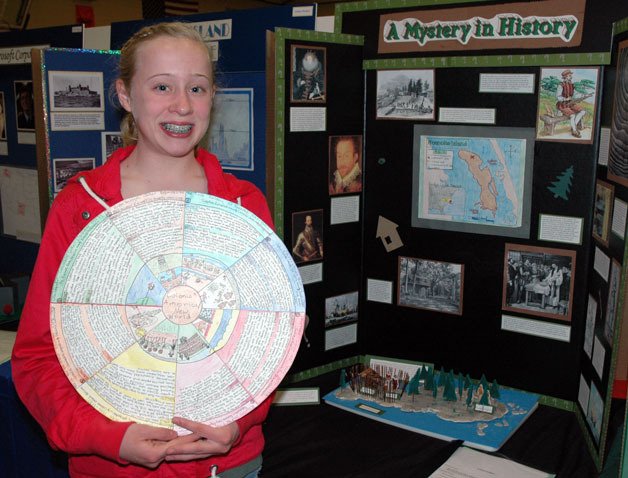ARLINGTON — For more than three decades, the Post Middle School gymnasium has hosted the research projects of the eighth-grade classes at their annual Social Studies Fair, and this year’s displays ranged from historic mysteries and wartime propaganda to local relics that tied into our nation’s growth over the years.
Eighth-grade student Max Fries lives near the railroad tracks by the Whitehorse Trail, and he brought a few rusted old railroad spikes for his “Riding the Rails” project display.
“I see that bridge as I’m going to and from school, and those old steam locomotives are really cool,” said Fries, who discovered some of the less-than-reputable methods that the Central Pacific and Union Pacific railroads had used to secure federal funding for the laying of their tracks in the latter half of the 19th century.
Fries’ booth included a map of the two railroad companies’ lines as of 1870, which showed a tight network of tracks in the eastern half of the United States, with only lines ending in Dallas and San Francisco venturing into the western half.
“People in the East wanted to get in on the Gold Rush, so railways would make tons of money charging them for tickets,” Fries said.
Fellow eighth-grader Emma Janousek had been interested in the “lost colony” on Roanoke Island, just off the coast of Virginia, ever since she was a little girl, so she was eager to delve into the reasons for its apparent disappearance.
“The main lesson I learned was that they needed to organize and plan better beforehand,” Janousek said. “I think they didn’t reach their full potential because they rushed into it.”
Janousek’s display included a model of the colony on a miniature Roanoke Island, albeit “obviously not to scale,” given the sizes of the model settlers and Native Americans, as well as a wheel-shaped visual aid outlining each of the steps that led from Columbus reaching America to the settling of the Roanoke Colony.
According to Post Middle School eighth-grade teacher Jane Downey, student Brianna Whisman started out with a very broad umbrella topic — the Civil War — which she ultimately whittled down to the relatively narrow focus of how photography affected the war.
“It’s always interested me how that difference of opinion split us into two completely difference countries,” said Whisman, whose fascination with photography owes greatly to her time working on the yearbook. “Matthew Brady set out to record the war from beginning to end for future generations, but he was upset about how excited people were about the war, so he showed them why they shouldn’t feel that way with their loved ones dying.”
Whisman noted that newspaper photography was the most immediate medium of its era, comparable to electronic mail today, and discovered that the dead were posed by photographers to make certain losses seem worse than they were in the wake of certain battles.
“What started out as a very general topic for her became very specifically about propaganda in the media,” Downey said. “Another student began by researching the Gold Rush before looking just at Levi Strauss. We always appreciate the community coming in to support this fair by checking out what our eighth-graders have done. They’ve worked very hard in the long term to produce 150 separate project displays. There’s a lot of learning going on here.”







